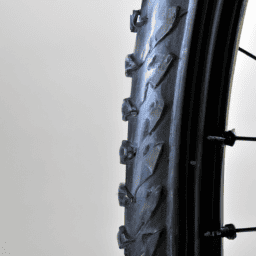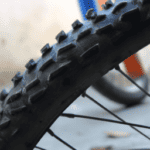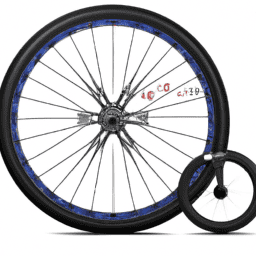As someone who is passionate about cycling, I understand the significance of choosing the correct tires for your bicycle. They not only play a crucial role in your performance but also have a substantial effect on your safety while riding.
However, with so many different types of bicycle tires available, it can be challenging to know how much you should be spending on them. In this article, I will provide you with a comprehensive guide on the cost of bicycle tires.
We will explore the different types of tires available, the factors that impact their prices, and how much you should be budgeting for them. Whether you are a seasoned cyclist or a beginner, this article will equip you with the knowledge you need to make an informed decision when purchasing your next set of bicycle tires.
Key Takeaways
- The average cost of bicycle tires is around $30-50, but can vary depending on size, type, and brand.
- Factors that affect the cost of bicycle tires include brand, size, materials, and technology used in construction.
- Continental and Schwalbe are known for producing high-quality and durable tires.
- Regular maintenance and occasional tire replacement are necessary for a safe and enjoyable ride.
Types of Bicycle Tires
You’ll want to consider the different types of bicycle tires available before making a purchase. These include tubeless or tubed tires, and knobby or slick tires.
Tubeless tires are becoming increasingly popular among cyclists because they offer better puncture protection, lower rolling resistance, and a smoother ride. They’re designed to seal the tire around the rim without the need for an inner tube.
In contrast, tubed tires require an inner tube to hold the air pressure and protect the rim from damage.
When it comes to tread patterns, knobby tires are better suited for off-road riding because they provide more traction and grip on loose or uneven terrain.
On the other hand, slick tires, also known as smooth tires, are better suited for smooth surfaces like pavement or concrete. They offer less rolling resistance and more speed, making them a great choice for road cyclists.
Knowing the differences between these types of tires will help you determine which one is best for your needs and budget. Factors that affect the cost of bicycle tires include the brand, size, materials, and technology used in their construction.
Factors that Affect the Cost of Bicycle Tires
When it comes to purchasing bicycle tires, there are a few key factors that can greatly affect the price.
As an avid cyclist, I know from experience that the brand, size, and quality of the tire can all play a role in determining its cost.
Different brands offer varying levels of quality and performance, while larger tires may require more material and therefore cost more.
Ultimately, it’s important to consider these factors and find the right balance of cost and quality for your specific cycling needs.
Brand
Although some may argue that brand isn’t important when it comes to bicycle tires, it’s worth noting that top brands may offer higher quality and durability, resulting in higher cost.
Brand popularity can also play a role in the cost of a bicycle tire. Popular brands may have higher production costs, which are passed on to the consumer.
Here are three things to keep in mind when considering the impact of brand on the cost of a bicycle tire:
-
Brand recognition: A well-known brand may have a higher cost simply because of its recognition and reputation in the market.
-
Research and development: Established brands invest in research and development to improve the quality and durability of their products. This can result in a higher price point.
-
Marketing and advertising: Popular brands often have a larger budget for marketing and advertising, which can contribute to the higher cost of their products.
Moving on to the next subtopic, the size of the tire can also affect its cost.
Size
Size definitely impacts how you feel while riding your bike, and it’s important to consider the effect it can have on your overall riding experience.
When it comes to bicycle tires, size refers to the diameter and width of the tire. The most common sizes are 700c and 26 inches for road and mountain bikes, respectively. However, there are variations in sizes that can affect the handling, speed, and comfort of your ride.
One important factor to consider is tire pressure. The correct tire pressure depends on the size of the tire and the weight of the rider. A higher tire pressure will make the tire harder and faster, but also less comfortable. On the other hand, a lower tire pressure will make the tire softer and more comfortable, but also slower.
Another factor to consider is the tread design, which affects traction and durability. A smoother tread is better for road riding, while a more aggressive tread is better for off-road riding.
Overall, choosing the right size and tire pressure can make a big difference in your riding experience and performance. Speaking of performance, the quality of the tire is another important factor to consider. While size and pressure can affect the feel of the ride, the quality of the tire can affect its lifespan and reliability. A high-quality tire will have better materials, construction, and durability, which can save you money in the long run by reducing the need for frequent replacements.
Quality
The quality of your bike’s tires can greatly impact their lifespan and reliability, making it a worthwhile investment to choose a high-quality option. When it comes to tire quality, there are two main factors to consider: durability vs performance and tread patterns.
Durability vs performance refers to the tradeoff between how long a tire will last versus how well it performs. High-performance tires are typically made from softer rubber compounds that provide superior grip and handling but wear out faster. On the other hand, more durable tires are made from harder rubber compounds that last longer but sacrifice some performance. The choice between the two depends on your specific needs and preferences.
| Durability | Performance |
|---|---|
| Lasts longer | Better grip and handling |
| Harder rubber compound | Softer rubber compound |
| Sacrifices some performance | Wears out faster |
Another important factor to consider is tread patterns. Tires with smooth tread patterns are best for road cycling because they provide the least rolling resistance, which allows for faster speeds. However, if you plan on doing any off-road or trail riding, you’ll want to opt for tires with more aggressive tread patterns. These patterns provide better traction on loose or uneven surfaces, but can slow you down on smooth roads.
In the next section, we’ll discuss the average cost of bicycle tires and how it relates to quality and features.
Average Cost of Bicycle Tires
On average, cyclists can expect to spend around $30-50 for a quality bicycle tire. However, this price can vary depending on the tire’s size, type, and brand.
When it comes to durability comparison, some brands are known for producing more long-lasting tires than others. For instance, Continental and Schwalbe are popular brands that are widely recognized for their high-quality and durable tires.
Although the initial cost of a bicycle tire may seem steep, it’s important to consider the long-term benefits of investing in a quality tire. Not only will it provide a smoother and safer ride, but it will also save you money in the long run by reducing the frequency of maintenance and replacement costs.
Speaking of which, in the next section, we’ll take a closer look at the maintenance and replacement costs associated with bicycle tires.
Maintenance and Replacement Costs
To keep your bike running smoothly, you’ll want to budget for regular maintenance and occasional tire replacement. One important aspect of maintenance is ensuring proper tire inflation. Underinflated tires can make it harder to pedal and decrease your speed. Overinflated tires can make your ride feel bumpy and increase your risk of a blowout.
It’s important to check your tire pressure regularly and adjust as needed to maintain a safe and efficient ride. Another factor to consider is the lifespan of your tire’s tread. Over time, your tire’s tread will wear down, decreasing traction and increasing your risk of slipping or losing control.
The lifespan of your tire’s tread depends on several factors, including the type of tire, the conditions you ride in, and how frequently you ride. As a general rule, replace your tires once the tread wears down to around 1/8 inch.
Staying on top of tire maintenance and replacement ensures a safer and more enjoyable ride. When buying new bicycle tires, consider important factors such as tire size, tread pattern, and intended use.
Tips for Buying Bicycle Tires
Looking for the perfect bicycle tire to fit your needs? Here are some tips to help you find the right one! One important factor to consider is the tread of the tire. Do you want a slick tire for smooth, fast riding on pavement, or a knobby tire for better traction on off-road terrain? If you primarily ride on paved roads, a slick tire may be the better choice. However, if you frequently ride on dirt or gravel paths, a knobby tire with deeper treads will provide better grip and control.
Another decision to make when choosing a bicycle tire is whether to go with a tubeless or tube tire. Tubeless tires are becoming increasingly popular as they offer several advantages over traditional tube tires. For one, they are less prone to punctures since there is no inner tube to puncture. They also provide a smoother ride by allowing you to run lower tire pressure without the risk of pinch flats. On the other hand, tube tires are generally less expensive and easier to install. Ultimately, the choice comes down to personal preference and the type of riding you will be doing. Consider your needs and budget carefully before making a decision.
| Pros of Tubeless Tires | Cons of Tubeless Tires |
|---|---|
| Less prone to punctures | More expensive |
| Smoother ride with lower tire pressure | Can be difficult to install |
| Require special tubeless-ready rims |
| Pros of Tube Tires | Cons of Tube Tires |
|---|---|
| Less expensive | More prone to pinch flats |
| Easier to install | Heavier than tubeless tires |
| Inner tube can be punctured |
Overall, when it comes to choosing the right bicycle tire, it’s important to consider your riding needs and preferences. The tread pattern and tubeless/tube tire decision can greatly impact your cycling experience. Take the time to research and make an informed decision for a smoother and more enjoyable ride.
Frequently Asked Questions
Can I use any type of bicycle tire on my bike?
Yes, tire compatibility depends on the bike’s rim size and frame clearance. It’s important to match the tire size to the rim size and consider the clearance for mud and debris. Always consult the bike’s manual for recommended tire sizes and types.
How often should I replace my bicycle tires?
I always keep an eye on my tire wear indicators. When they start to show, it’s time to replace my bicycle tires. Properly inflated tires also help prolong their lifespan.
Is it more cost-effective to replace a punctured tire or repair it?
When deciding whether to repair or replace a punctured bicycle tire, consider the pros and cons of each option. Repairing a tire may be cheaper, but it may only be a temporary fix. Replacing the tire may be more expensive upfront, but it may be a longer-lasting solution. A cost comparison of the two options should be made to make the best decision.
What should I look for in a good quality bicycle tire?
When choosing a bicycle tire, I consider the balance between durability and performance. Tubeless tires offer better puncture resistance and lower pressure, while tube tires are more affordable. It’s important to select a reputable brand and proper size for optimal performance and safety.
Can I mix and match different brands of tires on my bike?
Yes, brand compatibility is important when mixing and matching different tires on a bike. Matching tire sizes and tread designs from the same brand ensures optimal performance and handling. Mixing brands can affect performance and may not be recommended.
Conclusion
Overall, the cost of a bicycle tire depends on a variety of factors, such as the type of tire, size, durability, and quality. As a cyclist, it’s important to invest in a good quality tire that suits your needs and preferences. While the initial cost may seem high, it’s important to remember that a good tire can last for thousands of miles if properly maintained.
In conclusion, purchasing a bicycle tire can be compared to buying a pair of shoes. Just like shoes, tires are essential for comfort, safety, and performance. While there may be cheaper options available, investing in a high-quality tire is worth it in the long run.
By considering the factors that affect the cost of bicycle tires and following maintenance and replacement guidelines, cyclists can ensure that their tires provide a smooth and safe ride for many miles to come.
















